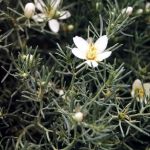| Common Name: |
Harmal |
| Other Names: |
Syrian Rue, Harmel |
| Botanical Name: |
Peganum harmala |
| Genus: |
Peganum |
| Family: |
Zygphyllaceae |
| Native Location: |
S Europe, N Africa, and subtropical Asia. |
| Cultivation: |
Well-drained to dry, poor soil in sun. |
| Propagation: |
By seed sown in late spring; by division in late spring. Subject to statuatory control as a weed in parts of Australia. |
| Harvest: |
Whole plants and roots are collected as required for decoctions and inhalations. Fruits and seeds are collected when ripe. Fruits are pressed for dye. Seeds are pressed for oil, dried, and used whole or powdered in infusions, embrocations, and ointments. |
| Height: |
50-90cm (20-36in) |
| Width: |
45-60cm (18-24in) |
| Hardiness: |
Z8 |
| Parts Used: |
Whole plant, roots, fruits, seeds, oil. |
| Properties: |
A bitter, spicy, diuretic herb that stimulates the uterus and digestive system, relieves pain, expels intestinal parasites, and is reputedly aphrodisiac and purifying. In large quantities, is emetic. |
| Medicinal Uses: |
Locally, internally for stomach complaints, urinary and sexual disorders, epilepsy, menstrual problems, nervous and mental illnesses. Excess causes hallucinations and vomiting. Externally for hemorrhoids, rheumatism, skin diseases, and baldness; also burned and inhaled for headaches (whole plant), and smoked for toothache (roots and seeds). |
| Culinary Uses: |
Seeds are used as a spice (Turkey). |
| Economic Uses: |
Fruits yield a red dye. |
| Bibliography: |
Encylopedia of Herbs by Deni Brown Copyright ©: 1995, 2001 Dorling Kindersley Limited pg 304
|

